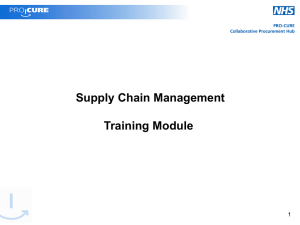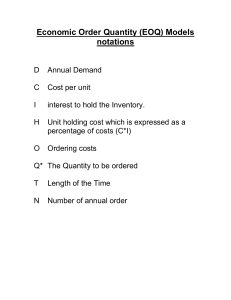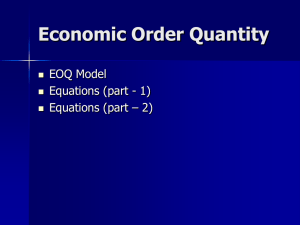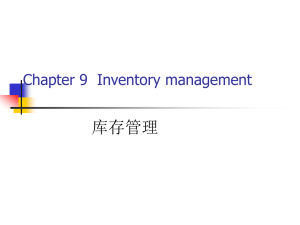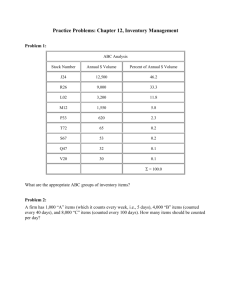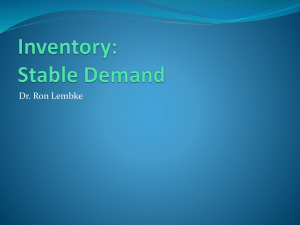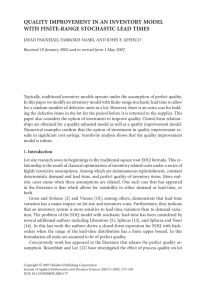Order Quantity with Price-Break: EOQ & ABC Analysis
advertisement
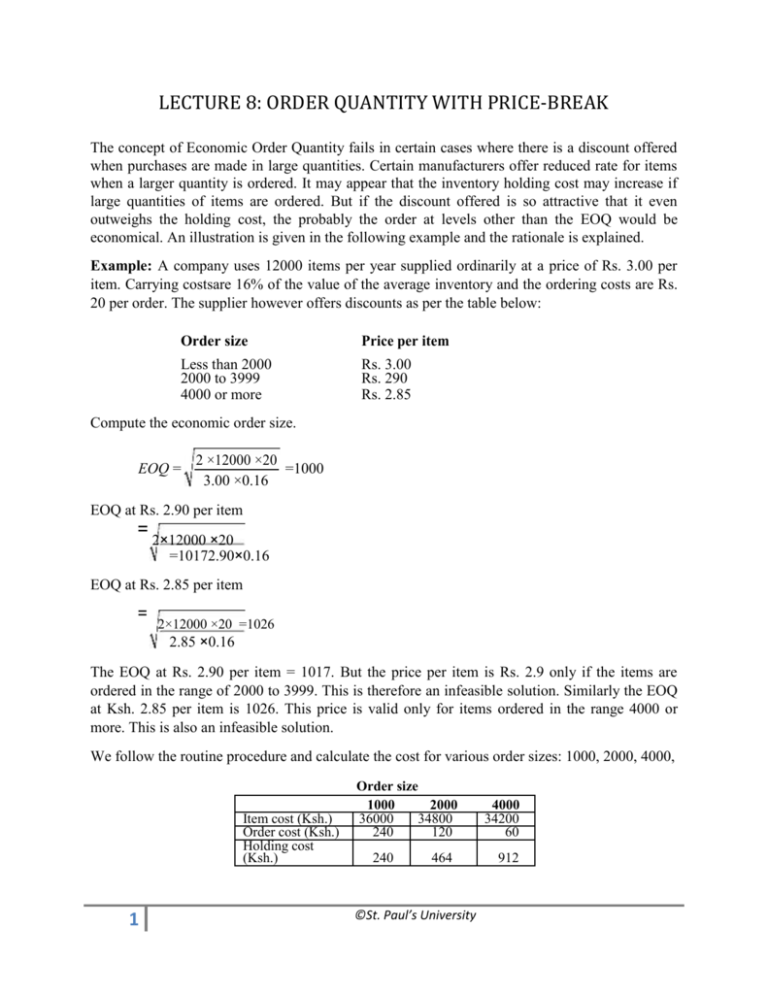
LECTURE 8: ORDER QUANTITY WITH PRICE-BREAK The concept of Economic Order Quantity fails in certain cases where there is a discount offered when purchases are made in large quantities. Certain manufacturers offer reduced rate for items when a larger quantity is ordered. It may appear that the inventory holding cost may increase if large quantities of items are ordered. But if the discount offered is so attractive that it even outweighs the holding cost, the probably the order at levels other than the EOQ would be economical. An illustration is given in the following example and the rationale is explained. Example: A company uses 12000 items per year supplied ordinarily at a price of Rs. 3.00 per item. Carrying costsare 16% of the value of the average inventory and the ordering costs are Rs. 20 per order. The supplier however offers discounts as per the table below: Order size Price per item Less than 2000 2000 to 3999 4000 or more Rs. 3.00 Rs. 290 Rs. 2.85 Compute the economic order size. EOQ = 2 ×12000 ×20 =1000 3.00 ×0.16 EOQ at Rs. 2.90 per item = 2×12000 ×20 =10172.90×0.16 EOQ at Rs. 2.85 per item = 2×12000 ×20 =1026 2.85 ×0.16 The EOQ at Rs. 2.90 per item = 1017. But the price per item is Rs. 2.9 only if the items are ordered in the range of 2000 to 3999. This is therefore an infeasible solution. Similarly the EOQ at Ksh. 2.85 per item is 1026. This price is valid only for items ordered in the range 4000 or more. This is also an infeasible solution. We follow the routine procedure and calculate the cost for various order sizes: 1000, 2000, 4000, Item cost (Ksh.) Order cost (Ksh.) Holding cost (Ksh.) 1 Order size 1000 2000 36000 34800 240 120 240 464 ©St. Paul’s University 4000 34200 60 912 Exercises 1. Assume the following price structure Units 0-199 200-399 400-599 600 Units Price Rs. 10.00 9.75 9.50 9.25 Purchase cost per order = Ks. 25 Cost of the item = Ksh. 10 Annual demand = 950 Units Carrying cost =Ksh2/Unit/yr 2. Find the optimal order quantity for a product for which the price-breaks are as follows: Items q 0 ≤ q < 100 100 ≤ q < 200 200 ≤ q Price/Unit Rs. 20 Rs. 18 Rs. 16 The monthly demand for the product is 600 units. The storage cost is 15% of unit cost and the cost of ordering is Ksh. 30 per order. DYNAMIC ORDER QUANTITY The basic assumption in the derivation of Economic Order Quantity models discussed previously is that the demand is uniform. But in certain situations the demand is not uniform. It may rise and fall, depending on seasonal influences. A general method is discussed below that can be applied to any pattern of varying demand due to seasonal or irregular variations. Consider the following example to illustrate how a varying demand problem can be tackled. This is known as Dynamic Order Quantity model. Example: The requirements for 12 months are given below: Month Requirement Set up cost Unit price Interest 1 20 2 40 3 10 4 10 5 10 6 2 7 40 8 30 9 40 10 40 11 10 12 20 = Rs. 20 = Rs. 5 per item. = 24% per year or 2% per month. Solution: To calculate the dynamic order quantity we can adopt the following procedure. The first month's requirement has to be ordered in the first month itself at a procurement cost of Rs. 20. Now we have to decide whether the second month's requirement can also be ordered along with first month's requirement. This involves additional carrying cost, but this will result in saving an extra set up. Hence if the saving on set up costs outweighs the carrying costs, then we 2 ©St. Paul’s University include the second month's requirements along with the first month. Similarly a decision can be taken whether to include the third month's requirement in the first month itself. This procedure is followed until the procurement costs and carrying costs are balanced. Let n represent the month, n = 1, 2, ..., 12. Let Rn be the requirement during nth month and Rn+1 be the requirement during (n + 1)th month. If the (n + 1)th month requirement namely Rn+1 is absorbed in nth month itself, the additional procurement cost is saved. Hence the saving in procurement cost is (C2/n). But the additional carrying cost is C3 n (Rn+1). If the additional carrying cost is less than the procurement cost, then the (n+1)th month requirement is to be ordered also with nth month. Hence we have to check whether nRn + 1 C3 < C2/n n2Rn + 1 < C2/C3 If the answer to the above inequality is yes, then, the future month's requirements are included in the first month itself. If the answer is 'no', then that requirement is to be ordered afresh and this is treated as month n = 1. In this example C2/C3 = 20/0.01 = 200. All the eleven information can be represented in the table as shown. Month. Requirement. Rn 1 2 3 4 5 6 Total 7 8 9 Total 10 11 12 Total 20 40 10 10 10 2 92 40 30 40 110 40 10 20 70 n n2Rn+1. 1 2 3 4 5 6 40 40 90 160 50 1440 Is n2Rn+1<200 Yes Yes Yes Yes Yes No 1 2 3 30 160 360 Yes Yes No include 10 in 7th month. include 40 in 7th month. set up again in month 10 1 2 10 80 Yes Yes include 10 in month 10 include 20 in month 10 Action. include 40 in month 1 include 10 in month 1 include 10 in month 1 include 10 in month 1 include 2 in month 1 set up again in month 7 Hence we order three times a year in the first month, seventh month and tenth month, the batch sizes being 92, 110 and 70 respectively. Exercise: Compute the dyanamic EOQ is for the following requirements. Month Requirement. 3 1 50 2 100 3 10 4 170 5 150 6 180 7 1 ©St. Paul’s University 8 260 9 100 10 80 11 150 12 200 ABC ANALYSIS The ABC analysis is the analysis that attracts management on those items where the greatest savings can be expected. This is a simple but powerful tool of statistical sampling in the area of inventory control or materials management. In this analysis, the items are classified or categorized into three classes, A, B and C by their usage value. The usage value is defined as, The ABC concept is based on Pareto's law that few high usage value items constitute a major part of th capital invested in inventories whereas a large number of items having low usage value constitute an insignificant part of the capital. It too much inventory is kept, the ABC analysis can be performed on a sample. After obtaining the random sample the following steps are carried out for the ABC analysis STEP 1: Compute the annual usage value for every item in the sample by multiplying the annual requirements bythe cost per unit. STEP 2: Arrange the items in decending order of the usage value calculated above. STEP 3: Make a cumulative total of the number of items and the usage value. STEP 4: Convert the cumulative total of number of items and usage values into a percentage of their grand totals. STEP 5: Draw a graph connecting cumulative % items and cumulative % usage value. The graph is dividedapproximately into three segments, where the curve sharply changes its shape. This indicates the three segments A, B and C. The class A items whose usage values are higher are to be carefully watched and are under the strict and continued scrutiny of the senior inventory control staff. These items should be issued only an indents sanctioned by the staff. The class C items on the other extreme can be placed on the shop floor and the personnel can help themselves without placing a formal requisition. The class B items fall in between A and C. ABC concept conforms to the consideration implied in the EOQ model. 'A' items have high inventory carrying costs and should therefore be placed with EOQ concept. The 'C' items require very little capital and have therefore low inventory carrying costs. Hence, they can be purchased in bigger lots. 'B' items are usually placed under statistical stock control. Example: Perform ABC analysis on the following sample of 10 items from an inventory. 1 Items Annual Usage 300 (Unit) Unit Cost 10 (Rs.) 4 2 3 4 5 6 7 8 9 10 2700 30 1000 50 220 160 800 600 70 15 10 5 4 100 5 5 15 10 ©St. Paul’s University Solution: STEP 1: Calculate usage value by multiplying annual usage of each item with its unit cost and tabulate them andassign rank by giving rank to the largest usage value as in table below. Items No. 1 2 3 4 5 6 7 8 9 10 Annual Usage 3000 40500 300 5000 200 22000 800 4000 9000 700 Ranking 6 1 9 4 10 2 7 5 3 8 STEP 2: Arrange items as per ranking and calculate cumulative usage and % cumulative value as in the table below. Rank 1 2 3 4 5 6 7 8 9 10 Item No. Annual usage 2 6 9 4 8 1 7 10 3 5 40500 22000 9000 5000 4000 3000 800 700 300 200 Cumulative % of cumulative Cumulative % Annual usage Annual usage of item 40500 47 10 62500 73 20 71500 84 30 76500 91 40 80500 94.2 50 83500 98 60 84300 98.6 70 85000 99.4 80 85300 99.8 90 85500 100 100 If you draw the figure, you will see that the curve changes at points (say) X and Y. The items upto X is classified as class A items and between X and Y as class B and the rest as class C items. SOME DEFINITIONS Lead-time: This is defined as the time interval between the placing of the orders and the actual receipt of goods. Lead-time Demand: This is the lead-time multiplied by demand rate. For example, if the leadtime is 3 weeks andthe demand is at the rate of 50 items per week, then the lead-time demand is 3 x 50 = 150 items. The lead-time may not be constant. For one batch, a vendor may take 45 days and for the next batch 50 days and so on. Lead-time itself is therefore a stochastic variable. This complicates the problem of accumulating stock over the period encompassed by the lead-time. Lead-time may also be forecast exponentially as is done with the demand. 5 ©St. Paul’s University Safety stock or Buffer stock: Lead-time demand is the stock level, which, on the average is sufficient to satisfy thecustomer's orders as the stocks are being replenished. "On the average" would mean that during this period of replenishment 50% of the customer's order can be filled and the remaining 50% may either be refused or back ordered to be filled later. The reason for this is obvious. Forecast is after all a point estimate only. If the demand is greater than the forecasts, the customers would not be serviced. If the demand is less then the forecasts, overstocking would occur. When these two variables, stock level and service to the customer, are summed up over thousands of stock level and service to the customer, are becomes a major problem for an organisation to find an acceptable compromise between the two. Sometimes the management in an organisation would like to limit the disservice to the customer down to 5% or 10% at the cost of extra stocking. This extra stock in excess of the lead-time demand is called the safety stock. Saftely stock may be expressed as percentages of the lead-time demand. It may be computed in different ways. Reorder level: This is defined as the level of the inventory at which the order is placed. It has generally twocomponents (i) Lead time Demand and (ii) Safety Stock. Reorder level (ROL) = Lead time demand (LTD) + Safety stock (SS). Computation of Safety Stock: As discussed earlier, if the demand exceeds the forecast, the result is bad service to the customer and if the demand is less than the forecast figure, this results in overstocking. Thus there is a forecast error. This error is assumed to be normally distributed, with zero mean. If the standard deviation of the forecast error is calculated, then safety stock may be set with the desired confidence level to result in not more the 5 or 10% shortages etc. There is another measure of variation, popularly known as mean absolute deviation (MAD), which can be computed far more easily. It can be routinely smoothed every period for obtaining better estimates of the safety stock. MAD is related to the standard deviation for a normal distribution as given by. MAD =2 πSD. Therefore, SD = π2MAD Now safety stock = Z (S.D) =Zπ2MAD =K MAD whereK is called service factor K=Zπ2 The safety stock is for just one period and has to be extended over the lead time. The necessary 6 ©St. Paul’s University formula has been derived by extensive simulation by statisticians and is given below. MADLT = (0.659+ 0.341 LT) MAD Safety stock over the lead-time =K(0.659 +0.341LT)MAD =Zπ2(0.659+0.34LT)MAD Example: A company uses annually 50000 units of raw materials at a cost Rs. 1.2 per item. Ordering cost of items isRs. 45 per order and item carrying cost is 15% per year of the average inventory. 1. 2. Find the economic quantity. Suppose that the company follows the EOQ policy and it operates for 300 days a year, that the procurement time is 12 days and mum, minimum and average inventories. Solution: D = Demand = 50000/year C1 = Rs. 1.2 per item No. of days = 300/year C2 = Rs. 45 per order Lead time = 12 days C3 = 15% of Rs. 1.2/item/year. = Rs. 0.18 per item per year. Safety stock = 500 (1)EOQ= 2C D 2 = C3 2×45 ×50000 0.18 = 25000000 =5000 (2) Requirement per day = 50000/300 Lead time demand = 12 x 500/3 = 2000 Safety stock = 500 = Lead time demand+ safety Reorder level stock 7 ©St. Paul’s University = 2000 + 500 = 2500 Maximum inventory = E.O.Q + Safety stock = 5000 + 500 = 5500 Minimum inventory Average inventory = Safety stock = 500 = (Max. Inv. + Min. Inv.)/2 = (5500 + 500)/2 = 3000 Example A scrutiny of past records gives the following distributions for lead time and daily demand during lead time. Lead time distribution Lead time (days) Frequency 3 2 4 3 5 4 6 4 7 2 8 2 9 2 10 1 Demand distribution Demand/day (units) Frequency 0 2 1 4 2 5 3 5 4 4 What should be the buffer stock? Solution: Computation of average or mean lead time. =∑ (Frequency ×lead time) ∑ Frequency =6+12 +20 24+ 14+6 18+ 10+ + 20 =6 days Average demand =∑ (Frequency ×demand/day) ∑ frequency =0+4 +10 15+ 16+10 +6 14+ + 25 =3 Average lead-time demand = Average lead time x Average demand/day = 6 x 3 = 18. Maximum lead-time demand. = Max. lead time x Max. demand/day 8 ©St. Paul’s University 5 2 6 1 7 2 = 10 x 7 = 70 ∴ Buffer stock = Max. lead time demand - Average lead time demand *Example 7.7.3 For a fixed order quantity system find the EOQ, SS, ROL and average inventory for an item with the following data. Demand = 10000 item unit cost= Re 1 Order cost = Rs.12 Holding cost = 24% Post lead times = 13 days Solution: (1) EOQ= 2C D 2 C 3 2×12 10000× = =1000 items 0.24×1 (2) The Average lead time = (13 + 14 + 15 + 16 + 17)/5 = 15 days ( 30days time is omitted) Maximum lead time = 30 days Safety stock = ( 30 - 15) x 10000/(30 x 12) = 420 (3) Reorder level = Lead time demand + Safety stock = 417 + 420 = 837 (4) Average inventory = (1420 + 420)/2 = 1840/2 = 920. Example: An airline has determined that 10 spare brake cylinders will give them stock out risk of 30%, whereas 14will reduce the risk to 15% and 16 to 10%. It takes 3 months to receive items from supplier and the airline has an average of 4 cylinders per month. At what stock level should they reorder assuming that they wish to maintain an 85% service level. Solution: Lead time demand = 3 x 4 = 12 items 9 ©St. Paul’s University Safety stock at 85% service = 15% disservice or 15% stock out risk = 14 items Reorder level = 12 + 14 = 26 items. Example: Data on the distribution of lead time for a motor component were collected as shown. Management wouldlike to set safety stock levels that will limit the stock out to 10%. Lead time (weeks) Frequency of occurrence 1 2 3 4 5 6 7 8 10 20 70 40 30 10 10 10 How many weeks of safety stock are required to provide the desired service level? Solution: Lead time (weeks) Frequency 1 2 3 4 5 6 7 8 10 20 70 40 30 10 10 10 200 Probability Cumulative Probability 0.05 0.05 0.10 0.15 0.35 0.50 0.20 0.70 0.15 0.85 0.05 0.90 0.05 0.95 0.05 1.00 Average lead time = ∑(lead time x frequency)/ ∑frequency = (10 + 40 + 210 + 160 + 150 + 60 + 70 + 80)/200 = 770/200 = 3.85 weeks Upto 90% service level max.lead time is 6 weeks. Hence 6 - 3.85 = 2.15 weeks of stock would provide the service level of 90% (Note: If the lead time is given as a continuous time distribution take the mid point.) Example: Demand for a product during an order period is assumed to be normally distributed with mean of 1000units and standard deviation of 40 units. What % service can a company expect to provide (i) if it satisfies the average demand only (ii) if it carries a safety stock of 60 units. Solution: 1. 10 If the company provides only average demand, we can expect only 50% service ©St. Paul’s University 2. level. The standard normal variate Z is computed with the following formula. Z = (Safety stock - 0)/ Standard deviation = (60 - 0)/40 = 1.5 The area under normal curve for Z =1.5 is 0.4332. ∴ Service level = 0.50 + 0.4332 = 0.9332 04 93.32% Example: A manufacturer of water filters purchases components in EOQ's of 850 units/order. Total demandaverages 12000 components per year and MAD = 32 units per month. If the manufacturer carries a safety stock of 80 units, what service level does the this give the firm? Solution: Standard deviation = 2 ×MAD =MAD / 0.8 32= / 0.8 40= π Z = (S S - 0)/S.D = (80 - 0)/40 = 2 The area under normal curve for Z = 2 = 0.4772. Service level = 0.9772 or 97.72% Example: A firm has normally distributed forecast of usage with MAD = 60 units. It desires a service level, whichlimits the stock, outs to one order cycle per year. (1) How much safety stock should be carried if the order quantity is normally a week's supply? (2) How much safety stock should be carried if the order quantity is weeks supply. Solution: No. of orders = 52/year. 1 stock out in 52 weeks means a 98 % = (51/52) values For 98% area, the value of Z = 2.05 (from tables) S D = MAD/0.8 = 60/08 Z = (S S - 0 )/S D= (S S - 0)/60/0.8 2.05 = (S S - 0 ) x 0.8/60 SS = 2.05 x 60/0.8 = 154 units. (a)Number of orders = 52/5 11 ©St. Paul’s University 1 stock out = (52/5 - 1) Service level = (47/5)/(52/5) = 47/52 = 0.904 Z = 1.285 (for area = 0.404) MAD = 60 1.285 = S S/75 S S = 75 x 1.285 = 96 units. 12 ©St. Paul’s University

